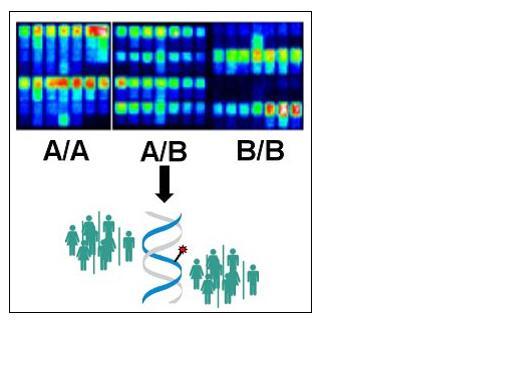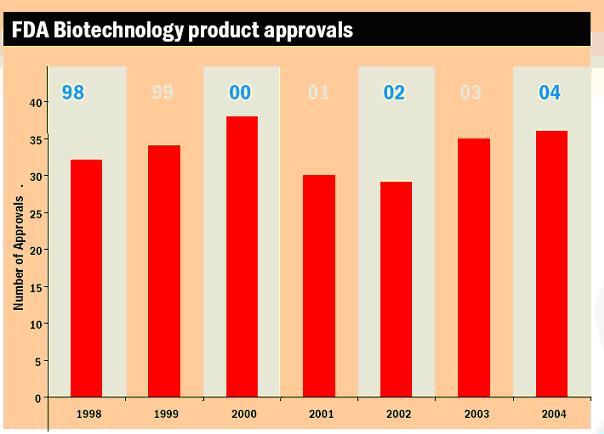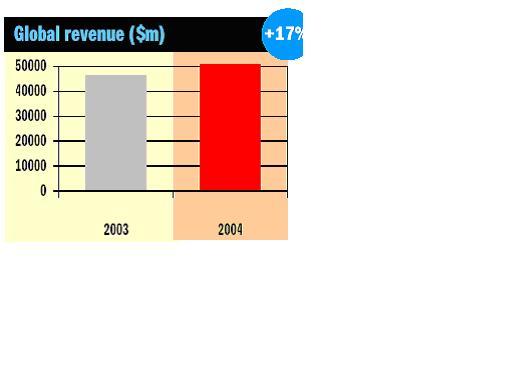The Future of Biotechnology for Medical Applications in 2005, Growth/Development Issues
Growth & Development of biotechnology industry
The cost of medical treatment
3. Is the recent growth of the cost for medical treatment sustainable? (The cost of health care insurance, which is directly linked to the cost of medicare, has grown about 10% annually partly caused by the growth of the biotech industry. This cost growth does not seem sustainable)
The recent growth of medical cost is not sustanaible. It is easy to predict that with a cost growth of about 10% per year/per person and a economic growth in the western world of about 2-3% the increasing medical cost is not sustanaible. The discussion about the cost of medical growth is related to the dicussion on the financial value of a life. If we can treat a fatal desease for half a million US dollar would we do so in the Netherlands? If we decide that a life is worth more than half a million dollat who is going to pay for this? (government, other people via health insurance, individual). Would we spent the same half million dollar in the congo for treatment of the same desease?
The state of the technology in Biotechnology
6. Has the industry reached its technological peak or has the biotechnological development just started? 7. Which new biotechnological developments are available? 22. Are there other technological innovations in diverse fields which could attract investor attention much more than bio-technology? 28. Will biotechnological innovations in other fields like agriculture (GE crops) and materials negatively impact the image and sustainability of innovations in the medical applications field?
The Human Genome Project – discovering the human blueprint. The human genome sequence provides an unrivalled new platform for research in human genetics. Projects at the Sanger Institute include genome annotation, development of new resources and technology, and their application to genetic disease.
The controversy There is no doubt that information from the Human Genome Project will provide huge benefits to human health with the diagnosis and possible treatment of genetic diseases (eg, cystic fibrosis and Huntington's chorea). However, some people feel that the huge amounts of money being spent on the project could be used to improve the human condition in more effective ways. Genetic information can be misused; for example, through genetic discrimination by employers or insurance companies. The ethical, legal and social issues need to be considered urgently because the project is proceeding more rapidly than expected and genetic information may be available before appropriate guidelines are in place.
Researchers set to find 'genetic signposts' for eight diseases (28th September 2005). The Wellcome Trust Case Control Consortium (WTCCC)
 One of the biggest projects ever undertaken to identify the genetic variations that may predispose people to or protect them from eight major diseases is to begin after receiving almost £9 million of funding from the Wellcome Trust.The Wellcome Trust Case Control Consortium (WTCCC) is a collaboration of 24 leading human geneticists, who will analyse thousands of DNA samples from patients suffering with different diseases to identify common genetic variations for each condition. It is hoped that by identifying these genetic signposts, researchers will be able to understand which people are most at risk, and also produce more effective treatments.
The biopharmaceutical market has undergone rapid expansion since its emergence thirty years ago. No longer is the market confined to growth hormones, insulin and red blood cell stimulating agents. Innovative science driven by the 2001 human genome project is accelerating the market into targeting a huge range of diseases from growth deficiency to arthritis to multiple sclerosis and orphan diseases such as Fabry's disease.
One of the biggest projects ever undertaken to identify the genetic variations that may predispose people to or protect them from eight major diseases is to begin after receiving almost £9 million of funding from the Wellcome Trust.The Wellcome Trust Case Control Consortium (WTCCC) is a collaboration of 24 leading human geneticists, who will analyse thousands of DNA samples from patients suffering with different diseases to identify common genetic variations for each condition. It is hoped that by identifying these genetic signposts, researchers will be able to understand which people are most at risk, and also produce more effective treatments.
The biopharmaceutical market has undergone rapid expansion since its emergence thirty years ago. No longer is the market confined to growth hormones, insulin and red blood cell stimulating agents. Innovative science driven by the 2001 human genome project is accelerating the market into targeting a huge range of diseases from growth deficiency to arthritis to multiple sclerosis and orphan diseases such as Fabry's disease.
Visiongain values the 2005 biopharma market at $70.8bn. Having grown 16.5% from 2004's revenues of $60.7bn, double-digit growth of the market will continue to the end of the decade. Composed of 9 major therapeutic areas including oncology, anti-infectives, vaccines and the market leader blood disorders, the market by 2010 is expected to represent 17% of all prescriptions written compared with 2004's 12%. At this pace of growth, biotech is now outgrowing Big Pharma.
The Future of Biotechnology
http://www.physicspost.com/articles.php?articleId=197&page=2 New breakthroughs will also be made against killers like AIDS and cancer, but progress towards a cure will be slow. The AIDS virus has only 9 genes, all of which have been carefully sequenced. In fact, the genetic family tree for AIDS has been deciphered, allowing scientists to reasonably conjecture that it started as a cross-over virus from the monkeys in Africa in the form of the simian virus SIDS, perhaps 50 years ago. However, the virus mutates so rapidly that any short-term cure for the disease seems unlikely. Lacking an effective gene correction mechanism, the AIDS virus is a moving target, mutating so fast it can evade any therapy designed against it, perhaps for years or even decades to come. Similarly, cancer will remain a stubborn disease for many years to come. Many cancers involve the successive mutations of 4 or more genes, and the total number of oncogenes and tumor suppressor genes is enormous. But new ways are being devised to attack cancer at the molecular level, including starving a tumor of its blood supply, using monoclonal anti-bodies, and even gene therapy. About 50% of all common cancers (e.g. lung, breast, colon cancers) involve mutations in just one gene, p-53. This means that by replacing damaged p-53 genes, we might be able to cure 50% of all common cancers. But the reality is not so simple. At present, a large number of the gene therapy trials being conducted today involve trying to fix the mutated p-53 gene, with only mixed results. One can show that the good p-53 gene is being absorbed into cancer cells, but that is not enough; we must show that all cancer cells are cured in this way, and this has not been done. So for the next five years, there will be spectacular breakthroughs in understanding the genetic basis for diseases, but progress towards cures for these diseases will be painfully slow. Within 10 years, scientists will have a vast encyclopedia of the genomes of perhaps hundreds to thousands of diseases and plants and animals. Computers will tediously and slowly discover the functions of these genes.
External pressures make it difficult to maintain the growth enjoyed by the pharmaceutical industry over the past two decades. Expenditure on R&D is increasing but is not accompanied by corresponding growth in the number of new drugs reaching the market. Companies must fundamentally review R&D business models and exploit new strategies for re-establishing core drug discovery expertise. The industry can expect the new drug discovery paradigm to be based upon the integration of fields, such as, genomics and proteomics, structural biology, chemistry, physiology, pharmacology and population biology, alongside the integration of the clinic and the laboratory

 Summary
The technology in biotechnology is very young. Biotechnology has hughe potential. The question for the biotechnology industry is if the industry is capable of using this potential and trasforming the potential into human care?
Summary
The technology in biotechnology is very young. Biotechnology has hughe potential. The question for the biotechnology industry is if the industry is capable of using this potential and trasforming the potential into human care?
Human Health.
25. Which diseases does bio-technology cure? What is the forecast of these diseases, expected to increase, stabilise etc? 26. What about the forecast of diseases in general? Are we expecting to see many more new diseases emerge like AIDS for example? Can Biotechnology be an answer?
Basically all deceases that are caused by genetic information or of which the cause can be attacked by genetic information (genetically modified organism) can be cured through biotechnology. The following diseases are already cured with the use of biotechnology or cure is expected within ten years; malaria, cholera, AIDS, cancer, growth deficiency, arthritis, tuberculosis, coronary heart disease, type 1 diabetes, type 2 diabetes, rheumatoid arthritis, Crohn's disease, ulcerative colitis, bipolardisorder, hypertension, multiple sclerosis, orphan diseases, Fabry's disease.
The treatment of these diseases is expected to growth for three reasons; aging world population, awareness and understanding of diseases (100 years ago you would die of MS without knowing what killed you), growing part of world population having access to advanced medical treatment (E.g. China, Brasil, India, etc.).
Remaining questions.
27. What are the long term effects of genetically modified organisms on the environment and on human health? Good question but hard to answer since we have no long term data available since the technology is new. It is very unlikely that generically modified organisms can have a negative long term impact as long as the technology is used approporiately. It is simular to nuclear technology that has very little negative affects as long as used appropriately. Gentic modification is done by mother nature as long as it excists. We are all ultimaltely genetically modified (evolution). The ethical question is do we allow ourselves to interfere/change evolution?
4. What percentile of the growth of medical treatment can be contributed to the biotechnolgy sector? à Increasing but no hard data available! à Cost of developping a new pharmaceutical product estimated 800 million US dollar. Only 1 out of 3 pharmaceutical products are able to recover R&D cost. (see also article “putting a price on biotechnology and biotech NPV calculator) ”The market by 2010 is expected to represent 17% of all prescriptions written compared with 2004's 12%. At this pace of growth, biotech is now outgrowing Big Pharma.”
21. Is there a substitute for biotechnology? No
Driving forces:
1. Technology, extremely large potential to further boost Biotech industry!
2. Finance and R&D:
a. What is the value of a human life?
b. Industry (R&D) very capital intensive and requires strong economic backbone
3. Current healt care systems will no longer be able to support high cost.
4. Global population (Human health) requires more/better healtcare